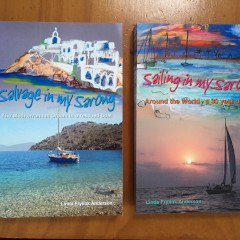
Sailing the Pacific
09 November 2010
07 November 2010
05 November 2010
26 October 2010
19 October 2010 | Somewhere between Fiji and Vanuatu
14 October 2010
14 October 2010
14 October 2010
14 October 2010
14 October 2010
03 October 2010
15 September 2010 | Vava'u, Tonga
02 September 2010 | Vava'u, Tonga
08 August 2010
29 July 2010
25 July 2010 | Bora Bora
20 July 2010
16 July 2010 | Moorea
16 July 2010 | Moorea, Society Islands
Farming the Black Pearl
03 October 2010
Isabelle
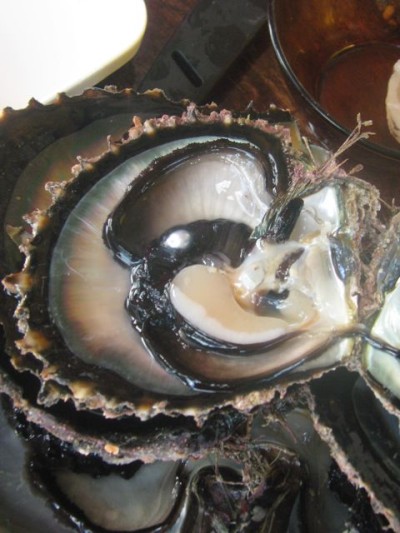
Inside the Black-Lipped Oyster, the black, slimy part is the lip
Although we are now in Fiji, I have been meaning to write a more detailed post on the process of farming the Black Pearl. I'm doing a little overland travel and nestled in a cheap but lovely hotel, I've finally found the time to write the post. Here it is.
"Every woman wants a string of pearls... Isn't that right Isabelle?" Peter asked me outside a pearl shop in Fakarava. I thought for a moment, not wanting to be just like 'every woman' but I had to answer "I don't know about every woman, but I do."
Why do many women want pearls? I have no idea, but I can tell you why I am happy that I have some.
Jamie and I were anchored in Kauehi's Lagoon. The first thing that hits you about the Tuamotus is how remote and desolate the islands are. Not much grows on the atolls except for coconut palms. The people in the Tuamotus have two main sources of wealth- copra; which is rancid coconut meat used to make coconut oil for perfumes, cosmetics and cooking oil and the other is the Black Pearl.
We both wanted to see how black pearls are made and went asking around town. Soon enough we met a family who were in the pearl business and agreed to take us out the next day to visit the farm and see how they graft pearls.

Different coloured buoys mark pearls which are in various stages of growth

The start of every workday begins with a dive for oysters
Arrou is the eldest son and best grafter in the family. He has been grafting for over 10 years. He was a stock bloke with dark skin and tattoos. We met him at his office, a rickety old weatherboard shed on stilts in the water.

Wedging the host shell open
He took an oyster and wedged it open with a metal clamp, explaining to us that a Black Pearl is called a Black Pearl not because of the colour of the pearl but because it is made by a Black-Lipped Oyster. A black pearl can be green, purple, black, white, silver or gold depending on the depth the pearl is farmed at. But most of the time, a healthy black pearl will be very dark in colour compared with white or pink pearls which are farmed in Australia, China and Japan.
He then took a different oyster and pried it open completely, looking at the colour of the shell inside. "bad colour" he said in English and put the oyster aside. He opened another one and said "good colour". I couldn't tell the difference. He proceeded to slice off the black lip of the oyster, sliced the bottom part of the lip off the black part and cut it into tiny little pieces. "Very Important" he assured us.
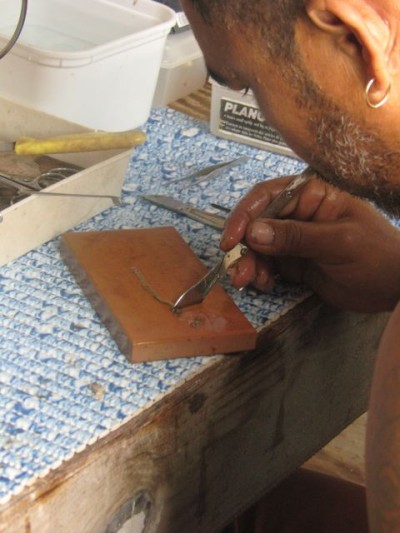
Arrou slices the lip ready to place it in an oyster with a shell nucleus
Arrou turned his attention to the oyster that was wedged open. He took a small, round marble type thing, "shell nucleus, Mississippi" he said and with the help of a serious looking piece of surgical equipment he made a neat incision in the body of the oyster before delicately placing the nucleus and the piece of oyster-lip inside. We now understood that by placing a piece of lip inside a host oyster, you could transfer any colour you wanted to start growing around the shell nucleus and that together, these would become your pearl.
He told us that this pearl would be checked every six months but only after two years would it reach a decent size. Once that oyster had made the first pearl successfully, a new and slightly larger shell nucleus would be inserted and the process would begin all over again. This would happen until the oyster became too tired to produce any more pearls. One oyster can make up to four pearls before it becomes too tired and this is reflected in the quality of the pearls. One oyster cannot make two pearls at the same time.
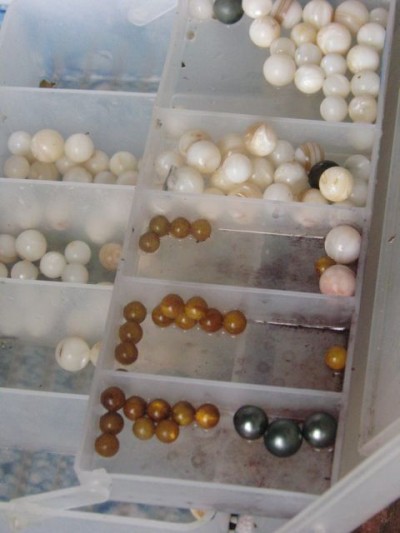
Shell nucleus from the Mississippi and three Black Pearls
The majority of pearls that are made are not the perfectly round ones you see in shops, rather there is a variety of shapes. There are baroques, which have rings around them creating an un-even surface, there are raindrops, and there are Geshi, which are tiny misshaped ones that look like little shiny meteorites (my favourites). Very rarely you will get a smooth round one with good lustre (reflective quality), this is why the round ones are worth more even though they are the most boring ones.
Nui, one of Arrou's work mates told us that the price of pearls has dropped in the past two years due to an influx of mass-produced pearls from China and Japan to international markets.
On an average work day, Arrou and his two mates graft up to four hundred pearls. Seeing them dive for the oysters, clean them off then check for pearls, you do come to appreciate how much work they put in and how long it would take to create a string of perfectly round pearls of the same quality, size and colour.

Arrou
The next day we went out to the farm again to see how the pearls were removed once ready. We took along some friends who had just arrived. At the end of the visit we did some serious pearl trading which was heaps of fun. We took fishing lures, hooks and alcohol all of which are hard to get in such remote places. We had a really good time bargaining and both sides were happy at the end of the day.
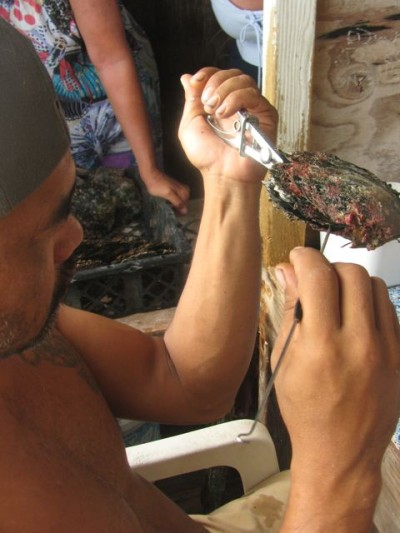
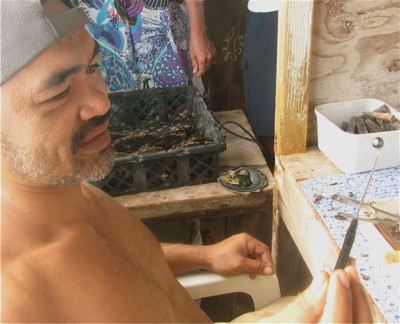
First pearl of the day
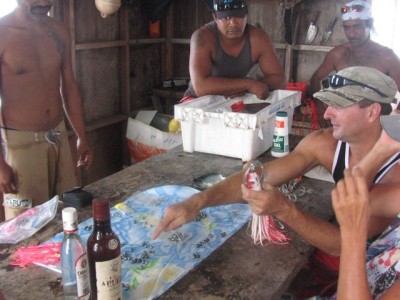
Derek asking how many pearls the 'big lure' is worth
Not only that but the myth of the Tahitian Pearl was busted. I would guess that most 'Tahitian Pearls' are actually farmed in the Tuamotus. They should be called the 'Tuamotan Pearl'.
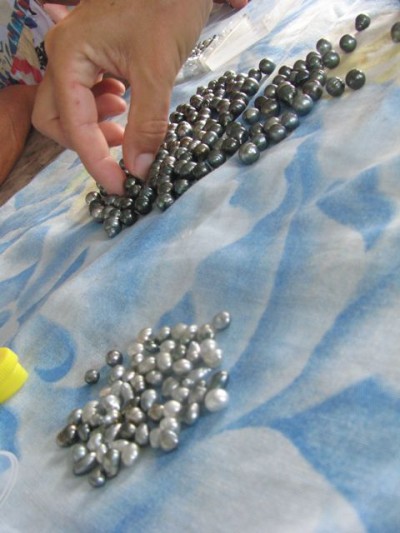
So to answer Peter's question, Yes, I do want some pearls. But what is more important than the fact that they are pretty and shiny is that they help me remember that I was there, in one of the remotest places on earth and I met a pearl farmer who showed me how they were created, who gave me Black Pearls for Rum and Gin and fishing gear and it was a great experience. I felt like a real pirate!
Although we are now in Fiji, I have been meaning to write a more detailed post on the process of farming the Black Pearl. I'm doing a little overland travel and nestled in a cheap but lovely hotel, I've finally found the time to write the post. Here it is.
"Every woman wants a string of pearls... Isn't that right Isabelle?" Peter asked me outside a pearl shop in Fakarava. I thought for a moment, not wanting to be just like 'every woman' but I had to answer "I don't know about every woman, but I do."
Why do many women want pearls? I have no idea, but I can tell you why I am happy that I have some.
Jamie and I were anchored in Kauehi's Lagoon. The first thing that hits you about the Tuamotus is how remote and desolate the islands are. Not much grows on the atolls except for coconut palms. The people in the Tuamotus have two main sources of wealth- copra; which is rancid coconut meat used to make coconut oil for perfumes, cosmetics and cooking oil and the other is the Black Pearl.
We both wanted to see how black pearls are made and went asking around town. Soon enough we met a family who were in the pearl business and agreed to take us out the next day to visit the farm and see how they graft pearls.

Different coloured buoys mark pearls which are in various stages of growth

The start of every workday begins with a dive for oysters
Arrou is the eldest son and best grafter in the family. He has been grafting for over 10 years. He was a stock bloke with dark skin and tattoos. We met him at his office, a rickety old weatherboard shed on stilts in the water.

Wedging the host shell open
He took an oyster and wedged it open with a metal clamp, explaining to us that a Black Pearl is called a Black Pearl not because of the colour of the pearl but because it is made by a Black-Lipped Oyster. A black pearl can be green, purple, black, white, silver or gold depending on the depth the pearl is farmed at. But most of the time, a healthy black pearl will be very dark in colour compared with white or pink pearls which are farmed in Australia, China and Japan.
He then took a different oyster and pried it open completely, looking at the colour of the shell inside. "bad colour" he said in English and put the oyster aside. He opened another one and said "good colour". I couldn't tell the difference. He proceeded to slice off the black lip of the oyster, sliced the bottom part of the lip off the black part and cut it into tiny little pieces. "Very Important" he assured us.

Arrou slices the lip ready to place it in an oyster with a shell nucleus
Arrou turned his attention to the oyster that was wedged open. He took a small, round marble type thing, "shell nucleus, Mississippi" he said and with the help of a serious looking piece of surgical equipment he made a neat incision in the body of the oyster before delicately placing the nucleus and the piece of oyster-lip inside. We now understood that by placing a piece of lip inside a host oyster, you could transfer any colour you wanted to start growing around the shell nucleus and that together, these would become your pearl.
He told us that this pearl would be checked every six months but only after two years would it reach a decent size. Once that oyster had made the first pearl successfully, a new and slightly larger shell nucleus would be inserted and the process would begin all over again. This would happen until the oyster became too tired to produce any more pearls. One oyster can make up to four pearls before it becomes too tired and this is reflected in the quality of the pearls. One oyster cannot make two pearls at the same time.

Shell nucleus from the Mississippi and three Black Pearls
The majority of pearls that are made are not the perfectly round ones you see in shops, rather there is a variety of shapes. There are baroques, which have rings around them creating an un-even surface, there are raindrops, and there are Geshi, which are tiny misshaped ones that look like little shiny meteorites (my favourites). Very rarely you will get a smooth round one with good lustre (reflective quality), this is why the round ones are worth more even though they are the most boring ones.
Nui, one of Arrou's work mates told us that the price of pearls has dropped in the past two years due to an influx of mass-produced pearls from China and Japan to international markets.
On an average work day, Arrou and his two mates graft up to four hundred pearls. Seeing them dive for the oysters, clean them off then check for pearls, you do come to appreciate how much work they put in and how long it would take to create a string of perfectly round pearls of the same quality, size and colour.

Arrou
The next day we went out to the farm again to see how the pearls were removed once ready. We took along some friends who had just arrived. At the end of the visit we did some serious pearl trading which was heaps of fun. We took fishing lures, hooks and alcohol all of which are hard to get in such remote places. We had a really good time bargaining and both sides were happy at the end of the day.


First pearl of the day

Derek asking how many pearls the 'big lure' is worth
Not only that but the myth of the Tahitian Pearl was busted. I would guess that most 'Tahitian Pearls' are actually farmed in the Tuamotus. They should be called the 'Tuamotan Pearl'.

So to answer Peter's question, Yes, I do want some pearls. But what is more important than the fact that they are pretty and shiny is that they help me remember that I was there, in one of the remotest places on earth and I met a pearl farmer who showed me how they were created, who gave me Black Pearls for Rum and Gin and fishing gear and it was a great experience. I felt like a real pirate!
Comments
| Vessel Name: | Dagmar |
| Vessel Make/Model: | CAL 39 |
| Hailing Port: | Melbourne, Australia |
| Crew: | James Thomson and Isabelle Chigros-Fraser |
| About: | |
| Extra: |
Gallery not available
'Twenty years from now you will be more dissapointed by the things that you didn't do than by the ones you did do. So throw off the bowlines. Sail away from the safe harbour. Catch the trade winds in your sails. Explore. Dream. Discover.' -Mark Twain


